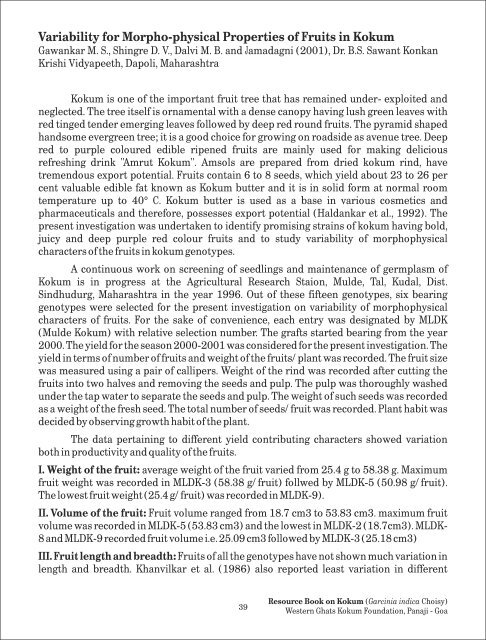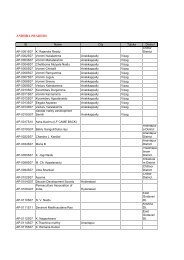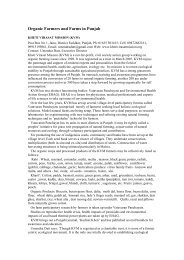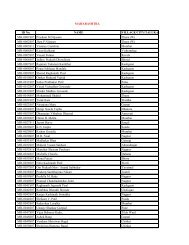Western Ghats Kokum Foundation - Organic Farming Association of ...
Western Ghats Kokum Foundation - Organic Farming Association of ...
Western Ghats Kokum Foundation - Organic Farming Association of ...
You also want an ePaper? Increase the reach of your titles
YUMPU automatically turns print PDFs into web optimized ePapers that Google loves.
Variability for Morpho-physical Properties <strong>of</strong> Fruits in <strong>Kokum</strong><br />
Gawankar M. S., Shingre D. V., Dalvi M. B. and Jamadagni (2001), Dr. B.S. Sawant Konkan<br />
Krishi Vidyapeeth, Dapoli, Maharashtra<br />
<strong>Kokum</strong> is one <strong>of</strong> the important fruit tree that has remained under- exploited and<br />
neglected. The tree itself is ornamental with a dense canopy having lush green leaves with<br />
red tinged tender emerging leaves followed by deep red round fruits. The pyramid shaped<br />
handsome evergreen tree; it is a good choice for growing on roadside as avenue tree. Deep<br />
red to purple coloured edible ripened fruits are mainly used for making delicious<br />
refreshing drink "Amrut <strong>Kokum</strong>". Amsols are prepared from dried kokum rind, have<br />
tremendous export potential. Fruits contain 6 to 8 seeds, which yield about 23 to 26 per<br />
cent valuable edible fat known as <strong>Kokum</strong> butter and it is in solid form at normal room<br />
temperature up to 40° C. <strong>Kokum</strong> butter is used as a base in various cosmetics and<br />
pharmaceuticals and therefore, possesses export potential (Haldankar et al., 1992). The<br />
present investigation was undertaken to identify promising strains <strong>of</strong> kokum having bold,<br />
juicy and deep purple red colour fruits and to study variability <strong>of</strong> morphophysical<br />
characters <strong>of</strong> the fruits in kokum genotypes.<br />
A continuous work on screening <strong>of</strong> seedlings and maintenance <strong>of</strong> germplasm <strong>of</strong><br />
<strong>Kokum</strong> is in progress at the Agricultural Research Staion, Mulde, Tal, Kudal, Dist.<br />
Sindhudurg, Maharashtra in the year 1996. Out <strong>of</strong> these fifteen genotypes, six bearing<br />
genotypes were selected for the present investigation on variability <strong>of</strong> morphophysical<br />
characters <strong>of</strong> fruits. For the sake <strong>of</strong> convenience, each entry was designated by MLDK<br />
(Mulde <strong>Kokum</strong>) with relative selection number. The grafts started bearing from the year<br />
2000. The yield for the season 2000-2001 was considered for the present investigation. The<br />
yield in terms <strong>of</strong> number <strong>of</strong> fruits and weight <strong>of</strong> the fruits/plant was recorded. The fruit size<br />
was measured using a pair <strong>of</strong> callipers. Weight <strong>of</strong> the rind was recorded after cutting the<br />
fruits into two halves and removing the seeds and pulp. The pulp was thoroughly washed<br />
under the tap water to separate the seeds and pulp. The weight <strong>of</strong> such seeds was recorded<br />
as a weight <strong>of</strong> the fresh seed. The total number <strong>of</strong> seeds/fruit was recorded. Plant habit was<br />
decided by observing growth habit <strong>of</strong> the plant.<br />
The data pertaining to different yield contributing characters showed variation<br />
both in productivity and quality <strong>of</strong> the fruits.<br />
I. Weight <strong>of</strong> the fruit: average weight <strong>of</strong> the fruit varied from 25.4 g to 58.38 g. Maximum<br />
fruit weight was recorded in MLDK-3 (58.38 g/fruit) follwed by MLDK-5 (50.98 g/fruit).<br />
The lowest fruit weight (25.4 g/fruit) was recorded in MLDK-9).<br />
II. Volume <strong>of</strong> the fruit: Fruit volume ranged from 18.7 cm3 to 53.83 cm3. maximum fruit<br />
volume was recorded in MLDK-5 (53.83 cm3) and the lowest in MLDK-2 (18.7cm3). MLDK-<br />
8 and MLDK-9 recorded fruit volume i.e. 25.09 cm3 followed by MLDK-3 (25.18 cm3)<br />
III. Fruit length and breadth: Fruits <strong>of</strong> all the genotypes have not shown much variation in<br />
length and breadth. Khanvilkar et al. (1986) also reported least variation in different<br />
39<br />
Resource Book on <strong>Kokum</strong> (Garcinia indica Choisy)<br />
<strong>Western</strong> <strong>Ghats</strong> <strong>Kokum</strong> <strong>Foundation</strong>, Panaji - Goa





